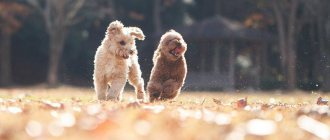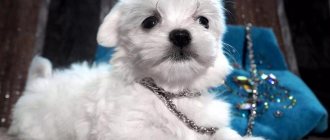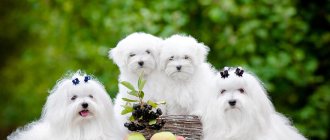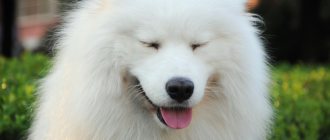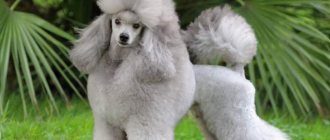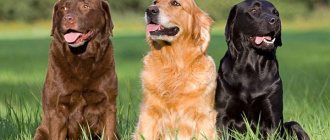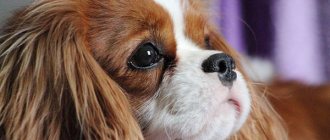The Royal Poodle is a dog that cannot be ignored.
Her appearance, proud and graceful gait and truly royal stature evoke admiration and attract attention.
These dogs are among the ten smartest breeds, which is another advantage.
As with any other breed, royal poodles have their own characteristics and maintenance nuances that you should be aware of before purchasing a puppy.
History of the breed
There is no reliable information about the place and time of the birth of the breed. However, it is certain that dogs resembling modern poodles existed in ancient times.
One version says that the birthplace of poodles is Germany. This theory is associated with the name of the breed, which is translated from German as “waterfowl”.
Another theory, which most scientists adhere to, says that poodles originated in France. This version is confirmed by the fact that the large (royal) poodle is the national breed of the country.
There is also debate about the ancestors of the breed. Some scientists say that poodles descended from divers and European herding dogs, others claim that their ancestors were barbets.
NOTE!
Initially, poodles were used to hunt water birds, and only representatives of the upper classes were allowed to keep and breed these dogs.
The first breed standard was established in the 17th century, so the rich history of the breed is not just words.
Contents in the apartment
In popular culture, poodles are presented as proud and pampered pets who lie on their high feather bed all day, only occasionally coming down for a meal. In fact, this is an active and curious dog, which has a very hard time sitting still.
Therefore, if you decide to get a poodle, make sure in advance that he has enough space and toys so that he can entertain himself in your absence.
Also, purchase a rug or bed in advance and accustom the dog to your “place” - otherwise, your pet will rest wherever he pleases: on the sofa, armchair, or even on the closet if the tomboy can jump there.
Another point that is worth considering if you plan to keep a dog in an apartment building is the “bark” of poodles. Teach your pet not to react to extraneous sounds from neighbors' apartments, not to howl or bark alone.
Description and standard
Royal Poodles are large, noble dogs with a harmonious, proportional build and a massive, but not heavy body.
The Official Standard for the Large Poodle describes them as follows:
- the head looks harmonious, the occipital protuberance is moderately massive, the forehead is not too protruding;
- the transition from the forehead to the muzzle is smoothed, the bridge of the nose is straight;
- lips of medium thickness, tightly fitting, the outer line is completely colored;
- the teeth are medium, white, straight, scissor bite;
- the eyes are small, almond-shaped, set straight;
- the ears are hanging, close to the muzzle, the ends are rounded;
- the body is rectangular in format, the body is muscular, the skin fits tightly, no folds are formed;
- the chest is deep, oval;
- the back is straight, the croup is slightly rounded;
- the paws are straight, even, the pads are small, oval.
As for the tail, the standard allows for both docking and natural length.
Distinctive features
The main positive distinctive feature of the breed can be considered variability. Poodles have several types of colors, two types of coat and four growth varieties:
- The Large Royal Poodle is the breed standard (45-60 cm);
- Small Poodle (35-45 cm);
- Miniature Poodle (28-35 cm);
- Toy poodle (up to 28 cm).
We suggest you read the article: “Little cute lamb - Miniature Poodle.”
All subspecies belong to the same standard and have the same proportions.
The latest breed standard was published in 2007, when a new shade of coat was recognized - red. Only high-quality puppies that do not have deviations in external characteristics are selected for breeding.
- The head is not refined, wedge-shaped, not too large, light. The brow ridges, stops and occipital protuberance are prominent
- The muzzle is wide and long, rounded at the end. The bridge of the nose is straight. The jaw is strong with a full set of teeth. bite (the upper teeth overlap the lower teeth). The lips are dense and thin.
- The nose is large. The color depends on the coat color.
- The eyes are slanted, almond-shaped, set wide apart at stop level. Color – black or brown.
- The ears are set high, drooping and close to the head. Long and thin.
- The body is strong and fit with a flat back line , a wide loin and a high croup (at the line of the withers). The chest is wide and deep. The neck is short, without dewlap, with a convex nape. The stomach is tucked.
- The tail is long and set high. Carried elevated, shaped like a sickle. Cupping is permitted in countries where the law does not prohibit it.
- The limbs are long, parallel, set straight and not too wide. The paws are rounded and collected. The gait is light and springy.
- The coat can be of two types: curly (uniform springy curls) or corded (long curls).
- Colors: apricot, red, gray, white, black, peach.
Character traits
Royal poodles have a cheerful, playful character. These are cheerful dogs who love active walks and games.
They need the owner’s constant attention, care and communication, and strive to spend maximum time with him, sometimes being too intrusive. Thanks to their innate powers of observation and excellent memory, representatives of this breed are able to instantly notice any changes in the behavior and mood of the owner and instantly adapt to them.
Large poodles are intelligent and quick-witted, making them quite easy to train. The main thing when training a dog is to show leadership qualities and perseverance, otherwise the pet will be cunning and evade classes. It is necessary to start raising a dog from early childhood; without proper training, a poodle will grow up willful, capricious and disobedient.
They are wary of strangers, always ready to rush to the owner’s defense, but do not show aggression - such behavior is not typical for them.
IMPORTANT!
Before purchasing a Royal Poodle, it is important to think seriously and evaluate your strengths. These dogs need a lot of time, they cannot be alone and need the company of their owner.
In addition, they require labor-intensive and expensive care, which should also be taken into account. If none of this makes you change your mind, you can safely buy a puppy - a cheerful, active, cheerful pet will be devoted to its owner all its life and will give many positive emotions.
Strengths and weaknesses of character
The Royal Poodle combines two incompatible character traits: he is very affectionate, but at the same time willful. A dog dotes on its owner and the rest of the family; it can become an excellent friend for a child, patiently putting up with being pulled by the ears and tail.
The poodle subtly senses the true attitude of a person towards himself: if he sees aggression, neglect and disrespect, he will not obey, demonstrating all his aristocratic pride and stubbornness.
The poodle is universal in its temperament: it can easily adapt to the rhythm of life of a tireless athlete, and will happily take a nap on the sofa next to a couch potato or go hunting.
Reference! Royal poodles show excellent results in agility (canine sports competitions).
Dogs of this breed are distinguished by a high IQ: they enthusiastically engage in the learning process and absorb new knowledge like a sponge. They like to overcome themselves and receive praise and treats from their owner for this.
One of the character flaws is the habit of barking for no reason, but with proper training, a dog can be weaned from doing this.
Advantages and disadvantages
The grace and aristocracy that emanate from royal poodles, and their attractive and impressive exterior in general, are far from the only advantages of these dogs.
The advantages of representatives of this breed are also:
- cheerfulness;
- cheerful character;
- devotion;
- endurance;
- intelligence and intelligence;
- lack of aggression;
- security qualities;
- lack of specific odor and shedding.
NOTE!
In addition, these dogs get along well with other pets, get along well with children, and their fur does not provoke allergic reactions.
Disadvantages of the breed:
- irritability;
- wary attitude towards strangers;
- the need for constant attention;
- need for long and active walks;
- inability to be alone;
- difficult care.
Large poodles are also noted for their tendency to bark loudly, often without cause.
Proper nutrition
Due to the fact that poodles are prone to obesity and diabetes, it is very important to feed your pet properly and they should never be overfed.
If the poodle eats ready-made food, then it must be selected based on the size of the dog, as well as its state of health and mobility. During the period of intensive breeding, as well as during stress and increased physical activity, if the dog, for example, is preparing for an agility competition, it is recommended to switch the dog to a more nutritious diet, and feed older poodles with food with a reduced protein content.
Natural feeding for dogs of this breed should be based on animal protein products. You need to add a little porridge and vegetables to them, and from time to time you can pamper the poodle with a piece of hard cheese or fruit that does not cause allergies, for example, an apple or banana.
NOTE!
Dogs suffering from chronic diseases, such as urolithiasis or obesity, as well as animals with allergies, are recommended to be fed with special dietary foods.
Photos of colors
According to the FCI system, there are 6 standard coat colors for large poodles. The main condition for compliance with the standard is that the color must be uniform, without transitions of shades or inclusions of other colors.
Black
Black is the most common color of poodles.
Black wool, in comparison with other colors, is considered the highest quality. To meet the standard, the black color must be bright, rich, different in depth and intensity. An admixture of other shades or tints of other colors are unacceptable.
White
Newborn puppies may have yellowish spots on the chest, ears, and bottom of the paws, but as they grow older they disappear. Puppies are also allowed pink pigmentation on their nose and paw pads, which will darken over time.
Silver
The coat can be any shade of gray, but there should be no black or white hairs. These poodles are born with black hair, which gradually becomes lighter at 2 months.
Brown
The coat is a rich brown, almost chocolate, color without the presence of light brown and beige shades. As the dog ages, it becomes more patchy.
Apricot
Such poodles are distinguished by their apricot-colored coat, without the presence of dark brown and white hairs. The ears may be slightly richer than the body.
Red (red)
The coat is the color of mahogany, the skin is the same shade.
Attitude towards children and pets
Being sociable and friendly dogs, representatives of this breed easily get along with everyone, especially children. Both are curious, active and love games, so they quickly become friends and spend time together.
The poodle steadfastly endures all the baby’s pranks, allowing itself to be considered a “living toy.” If a child shows excessive importunity or rudeness, although not consciously, the poodle will not get into a fight with him, will not bite or show aggression, he will simply end the game, leave and will avoid the child in the future.
Thanks to their easy-going nature and sociability, these dogs also get along well with other animals, be they dogs, cats, rodents or birds.
Key points in training
This breed is considered one of the most capable. Its representatives can often be found in the circus arena and in show programs. Poodles quickly remember commands and strive to carry them out. They enjoy being trained and serving their owner.
Despite this, their high level of intelligence can play a cruel joke on a person. Such dogs are often cunning and evade the task. The owner must immediately stop such behavior so as not to raise a manipulator.
You need to start training a dog from 3-4 months, but educate it from early childhood. The puppy must understand the hierarchy in the family and learn to listen to all members of the household. He will get used to his name and routine by 2-3 months. Then you can study the commands.
To show human dominance, you need to accustom your pet to several rules:
- Firstly, he receives food after the whole family has eaten.
- Secondly, the master's bed and furniture are taboo.
- Thirdly, the dog is the last one to enter the house.
- Finally, all attempts at begging are stopped.
Rude behavior is not acceptable. You cannot hit the dog, mock him, shout or swear. The worst punishment for a dog is an insult from the owner. Enough with a stern look, deprivation of treats and unsharp twitching. It is best to use a motivational method of education and game forms of training.
Poodles do well on agility courses. This kind of sport can help a person and a dog understand each other better and learn to listen. The pet will become more reserved and serious. You should not neglect the socialization of the puppy. It is worth periodically organizing walks in crowded places and introducing him to other animals.
Read about how to properly train a dog in the article: “Training a puppy: effective methods from dog handlers, learning commands at home.”
Care and maintenance
Caring for a royal poodle is a set of hygiene procedures that must be carried out regularly.
Wool and bathing
It is necessary to comb the coat of puppies daily; for adults, combing 2-3 times a week is enough.
After each walk, you need to wash the dog’s paws and belly; a complete wash using a specialized shampoo appropriate for the type of coat is required 3-4 times a month.
Eyes
Wipe with a cotton pad or napkin twice a week to remove accumulated secretions.
IMPORTANT!
If signs of disease are detected (redness, suppuration, increased lacrimation), it is necessary to show the dog to a veterinarian.
Ears
Regularly clean out any accumulations of wax and make sure that the ear canal does not become overgrown with hair; if necessary, pluck it out with tweezers.
Claws
If the claws do not grind down on their own during walks, they need to be shortened with a guillotine nail clipper 2 times a month. The cut should be filed with a nail file.
Education and training
The Royal Poodle enjoys following different commands and doing challenging exercises. But repeating the same actions can get boring, causing the dog to stop responding to its owner. To train, it is necessary to establish a trusting relationship with the animal. It should be trained with the help of affection and tasty rewards, but punishment and rough training can offend the poodle, after which it will not be able to trust its owner for a long time. If a dog is too naughty during training, a stern reprimand will be enough, because it is very sensitive to the mood and words of a person.
If the owner wants to train a show dog, he must begin training at 4 months. Initially, it is important to teach the royal poodle to take a certain position and not be afraid of strangers who are conducting an examination. Then it can be taught both standard dog commands and more complex ones.
Life expectancy and major diseases
The life expectancy of large poodles is 12-16 years, and proper care and suitable living conditions help to extend this period.
It is noteworthy that even with hereditary pathologies or any diseases, these dogs still live 10-12 years. Despite good immunity and good health, representatives of this breed are prone to diseases such as:
- diabetes;
- allergy;
- epilepsy;
- diseases of the cardiovascular system;
- retinal atrophy;
- increased lacrimation;
- deafness;
- otitis;
- dysplasia of the hip and elbow joints;
- glaucoma;
- disruptions in the functioning of the endocrine system;
- otitis;
- allergy;
- bloating;
- volvulus;
- epilepsy;
- hypothyroidism;
- lymphadenitis;
- von Willebrand disease;
- retinal degeneration;
- cataract;
- urolithiasis disease.
It is also not uncommon for adult individuals to experience early baldness and loss of shade saturation.
For routine examinations, you should contact your veterinarian at least 2 times a year.
Possible diseases and methods of treating them
Unfortunately, representatives of this breed are sickly. Doctors discover cataracts or otitis media in almost every poodle at the end of its life. Genetically, such dogs are predisposed to many eye and ear diseases. They cannot be treated without professional help.
Also common among them are: hip dysplasia, osteochondrosis, diabetes mellitus and other diseases. In dogs that suffer from ailments of the joints and muscles, coordination of movements is impaired. They should not be exhausted by stress; it is better to create comfortable conditions for home rest.
But those who are faced with diabetes or allergies will have to follow a diet. Less commonly, toy poodles are diagnosed with cancer. If malignant tumors are detected early on the surface of dog organs, it is possible to save them in an operable manner.
Dimensions and weight
The Royal Poodle is the largest representative of this dog breed.
The period of active growth of royal poodles lasts up to approximately 10 months, then up to 1.5 years they continue to develop and form.
The table below shows the size of the Royal Poodle depending on the gender of the dog:
| Floor | Height at withers, cm | Weight, kg |
| Male | 44-62 | 19-25 |
| Bitch | 42-55 | 18-23 |
General characteristics of the Royal Poodle breed
Royal poodles are classified as toy dogs based on their appearance only. Their ancestors were hunters, working dogs. Now they are among the smartest breeds. This dog is obedient, reacts almost instantly to his owner’s commands and obeys in 95% of cases.
Poodles like to work and learn. They can learn different tricks and perform in the circus. Nowadays, these beautiful dogs are most often used as companions. But they used to serve as rescuers, and they are especially good at pulling drowning people out of the water. Large poodles helped people in war and hunting. They have a keen sense of smell, they used to look for truffles, now they are sometimes used to search for mines, explosives, drugs, and are used in protective guard duty.
| Options | Characteristic |
| breed name | royal poodle |
| country of origin | France |
| group of breeds according to the ICF classification | ornamental and companion dogs |
| life expectancy | 10-18 years |
| height | male 44-62 cm, female 42-55 cm |
| weight | male 19-25 kg, female 18-23 kg |
| aggressiveness | non-aggressive, friendly |
| activity | high |
| intelligence | very smart, easy to train |
| working qualities | companion, circus dog, hunter |
| care | Difficult coat care, haircut required |
pros
The Royal Poodle is a popular pet and companion all over the world. Despite its large size, it gets along well in a city apartment. The breed has many advantages:
- takes second place in the ranking of the smartest dogs;
- easy to train, they are obedient;
- very loyal and loyal, not prone to dominance;
- treat children well, become attached to them, tolerate all pranks;
- gets along with any pets;
- easily adapt to the owner’s lifestyle;
- no shedding, no dog smell, suitable for allergy sufferers;
- attractive appearance, proud posture;
- by nature they are cheerful, sociable, cheerful, good-natured;
- These pets have good health, and with good care they live a long time.
Minuses
Despite its decorative appearance, the royal poodle is not a sofa dog. They have several disadvantages that may be a problem for some owners:
- they love to bark, the neighbors may not like it;
- these dogs must be cut; an uncut poodle looks very unkempt;
- they are very emotional by nature;
- mobile, need long walks;
- can't stand loneliness
- cunning, able to manipulate the owner;
- can be stubborn.
An interesting video about the breed, the advantages and disadvantages of royal poodles:
Video: Royal Poodle
Video: Royal Poodle - All about the dog breed
How and what to feed?
Each owner decides for himself what to feed his pet. These can be natural products or industrial feeds, the main thing is not to mix both types of food and make sure that the diet is balanced and contains all the necessary nutrients, vitamins and minerals.
If the choice falls on natural feeding, the royal poodle’s diet must include:
- lean meat;
- offal;
- sea fish;
- buckwheat and rice cereals;
- fruits vegetables;
- dairy products;
- eggs.
You should add a few drops of sunflower or olive oil to porridge - this is a source of vitamins and fatty acids.
It is strictly forbidden to feed representatives of this breed:
- fatty meat;
- smoked meats, sausages;
- river fish;
- grapes, raisins;
- nuts;
- chocolate and other sweets;
- rich pastries;
- garlic, onions;
- spicy, fried food;
- seasonings, marinades, pickles;
- carbonated drinks;
- legumes;
- mushrooms;
- tubular bones;
- products containing oxalic acid.
You should also not give your dog food from the common table, tea, coffee, or alcohol.
When choosing industrial food as the basis for a poodle’s diet, preference should be given to premium, super premium or holistic food. Such brands as Acana, Eukanuba, Orijen, Royal Canin, Purina Pro Plan have proven themselves well.
Breeding
Puberty occurs as early as 8 months. However, at an early age, mating is undesirable for poodles, since the female’s body has not completed growth. This can negatively affect both the health of the bitch and the condition of future offspring.
Royal poodles are ready to mate at one and a half years old. Both partners must be completely healthy.
Expert opinion
Anna Abramenko
An avid dog lover. Experience in veterinary medicine since 2009.
Ask a Question
For the first mating, it is better for a male to select an experienced female and bring her to him, and not vice versa. During the first mating, bitches may snarl and growl; this is considered a normal reaction.
It is recommended to keep a pregnant animal in a bright and warm room. You will need to provide her with a balanced diet and add vitamins to her diet. It is necessary to ensure that she does not overwork and does not make sudden movements. Pregnancy lasts 59-67 days. 2-3 puppies are born at a time.
How do puppies look and develop?
Like puppies of other breeds, Royal Poodles are born blind and deaf. 12-15 days after birth, their eyes and ear canals open, teeth appear on the 25th day, and by a month they are already leading a completely active life.
Both black and silver poodles are born with black fur. In the second, at 6-8 weeks the coat begins to change color and only then can one judge how the puppy will grow up.
A white representative of the breed usually has a slight yellowish tint at birth - this is normal, over time the dog will become completely white.
Origin
Today, poodles are commonly thought of as toy or show dogs. When the breed is mentioned, people usually think of the small variety or miniature toy poodles. However, previously the large royal poodle was a companion of trappers and was distinguished by excellent hunting qualities. The development of this breed took place mainly in Germany and France. Breeders in the two countries argued for a long time about who would have the right to poodles. In the end, France won. It was their description of the breed that was first included in the international register and later translated into other languages.
Types of haircuts
The breed standard approves 3 types of haircuts with which the dog will be allowed to participate in the exhibition:
- for a lion - cut the hair on the hind legs and body to the ribs, cut the muzzle from above and below to the eyes and on the cheeks, leave the mustache, a “pompom” of wool remains on the legs below and the tip of the tail;
- English strict - the front part of the body resembles a “lion” haircut, but in the area of the croup, in the groin and on the lower back, hair 1-2 cm long is retained; the muzzle, throat and front paws are shaved with a machine, leaving “pom-poms” below, hair on the head, the withers and nape are not cut;
- modern - during grooming they leave a lot of hair on the body, except for the paws and muzzle.
Other types of haircuts, such as kennel, Dutch, bichon, etc., are not allowed by the standard. However, if the pet does not apply for participation in exhibitions, you can choose any image for it.
And this is what an uncut royal poodle looks like:
How to cut your own hair?
Instructions for cutting a poodle in a lion style:
- fix the dog on the table in a standing position;
- remove hair from the cheeks, bridge of the nose, jaws and ⅔ of the neck with a machine;
- cut off the fur on the front legs, leaving only “pom-poms” in the pastern area;
- repeat the same with the hind legs;
- remove hair from the entire body to the chest;
- trim the fur on the belly and groin;
- remove the hair on the tail, leaving a “pompom” at the tip.
After this, the dog needs to be washed, dried with a hairdryer and combed. Then shape the resulting “vest”, “pom-poms”, “hat” and ears.
If this is your poodle's first time grooming and he is not familiar with clippers and scissors, you should ask for help holding the dog.
Approximate cost of a puppy
You should not buy a dog at the poultry market. It is better to purchase a purebred representative of the species in a nursery or at a breeding farm. There you will be provided with information about the baby’s parents, his state of health, and recommendations on care and feeding. The price of a puppy varies between 20-60 thousand rubles.
We recommend this article:
How to choose a healthy poodle puppy and name it beautifully
How to choose a puppy? Boy or girl?
Before buying a puppy, you need to carefully inspect it. Signs of a healthy dog that meets the breed standard:
- there is no increased lacrimation, eyes without redness;
- the ears are clean and do not emit an unpleasant odor;
- no rash, redness, irritation;
- scissor bite;
- no dandruff or bald patches;
- the lips are black or colored the color of the fur.
The puppy should behave actively, show curiosity, not be afraid of strangers and not show aggression.
Royal poodle females are calmer and more docile, they are more patient and more attached to their owner. Males have a more capricious character, they are more stubborn and need more frequent and longer walks. If you have plans for a pet's exhibition career, you should purchase a male dog if you plan to participate in the breeding of the breed - a female dog.
NOTE!
It is possible to determine what kind of puppy will be - large, medium or dwarf - only after he is 2 months old.
Nurseries in Russia and the CIS
Royal Poodles are a popular dog breed, so it is not difficult to find kennels that breed and sell them.
Here are some of them:
- Arwarox, Moscow;
- Atami, Moscow;
- Gently Born, Dolgoprudny;
- Moroshka's, Moscow;
- “Free Wind”, Samara;
- “From Mrs. Panina”, Cherepovets;
- “My Solo”, St. Petersburg;
- Danvik, St. Petersburg;
- FANCY TOY, Krivoy Rog, Ukraine;
- FLORIDA-IRIS, Ukraine, Kharkov region;
- GOLDEN BULLET, Ukraine, Makeevka;
- “Ruzhovy Svitanak”, Brest, Belarus;
- BRIDEL, Minsk, Belarus.
Specialized nurseries employ professional breeders and dog handlers who value their reputation, so the risk of purchasing a non-purebred or sick dog is minimal.
Price range
Prices for purebred royal poodles start from 15 thousand rubles, but most likely, such a puppy will not have a pedigree - the lack of documents allows breeders to reduce the cost of dogs.
A puppy with excellent characteristics will cost 20-25 thousand rubles, a show class representative can cost 60 thousand rubles. and more.
Of course, on the market or through an advertisement on the Internet you can find a puppy cheaper - for 5-7 thousand rubles, but there is no guarantee that he is a purebred and healthy representative of the breed.
Mating
Mating can be tribal or informal. In order for the puppies to have status and pedigree, you need to contact the nursery for a certificate for mating. A special form is filled out by the owners of the bitch and dog. The price for mating is set by the boy's owner. Usually it is 30% of the cost of puppies or one puppy. If the girl turns out to be empty, the mating is not paid for.
To determine the date, you need to monitor the female's cycles . The first heat usually begins at 8-10 months, but this period is considered too early. The best time for mating is 13-15 days of the third estrus: when the loop becomes loose and the discharge is light.
Before mating, a deworming procedure (cleansing of worms) and a medical examination are required. Animals must be vigorous and healthy.
Standard Poodles are large dogs that need a lot of space. The dogs are usually walked together and brought into the territory of the male dog. For the solution (the first time), you can invite a specialist who will help pets and owners understand the procedure. Usually the animals are helped: they are held and directed towards each other. The act will last no more than 10 minutes. In the absence of a lock, the female may be complete, but it is better to re-mate after 48 hours.
